February 2, 2023
Chamonix and the French Alps
We arrived by train in Chamonix, via a narrow mountain pass from neighboring Switzerland. Chamonix was destination #2 for my brother and I—two Americans skiing in Europe for the very first time. The Ikon pass (one of North America’s two skiing “mega-passes”) planted the idea in our minds. Alterra added Chamonix and Zermatt a few years ago, effectively reducing the cost of a European ski trip by … not much at all. But never mind the math. Every avid skier needs to visit the Alps at some point in their life. And here we were.
While the weather gods had blessed the American West with endless atmospheric rivers, it had left Europe largely high and dry. We had been in the Alps for nearly a week by now, and we had seen barely any clouds in the sky. But maybe that was for the best. The landscapes looked stunning and the outdoor dining proved delightful. Who needs powder?
And Chamonix was gorgeous. The storied village sits in an incredibly deep valley, surrounded by towering, jagged peaks. Chamonix hosted the world’s first Winter Olympics. Many consider it the birthplace of mountaineering. Trams and gondolas rise out of the village in seemingly every direction toward ski slopes. And lording over the valley is the Mont Blanc Massif, home to massive glaciers and Western Europe’s highest summit.
Ascent to the Aiguille du Midi
On day one in Chamonix we woke bright and early and set off through the village streets around 7 am. We stopped at one of the numerous small coffee shops for breakfast. Then we met our guide at the cable car in time for “first tram”.
Towering above us was the Aiguille du Midi (Noon Needle). The jagged summit formed one of several peaks in a massive wall of granite lining the narrow valley’s southern side. Chamonix sits just 3300′ above sea level. The Aiguille du Midi tops out just above 12,600′. Two back-to-back aerial tram rides would deliver us the full 9300 vertical feet in just three miles of cable. This system, completed in the 1950s, thus rises the vertical equivalent of two-and-a-quarter Jackson Hole trams.
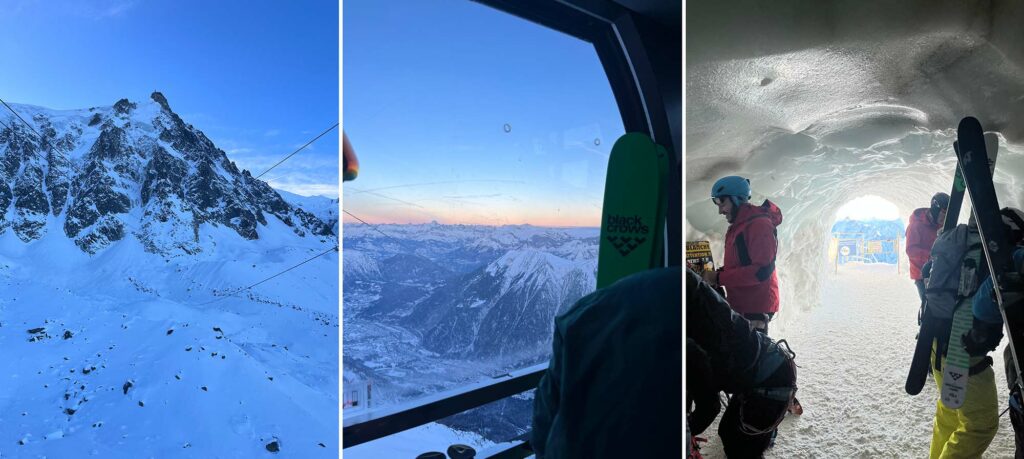
Atop the peak, the tram delivers riders to a network of tunnels blasted into the granite summit. Windows poke out in all directions, affording views of Chamonix, Mont Blanc, the Vallée Blanche, and peaks and valleys beyond. We explored the complex, riding an elevator to a tiny metal tower atop the peak. And we gazed, for the first time, at the Vallée Blanche, a massive glacier cascading down the slopes of Mont Blanc.
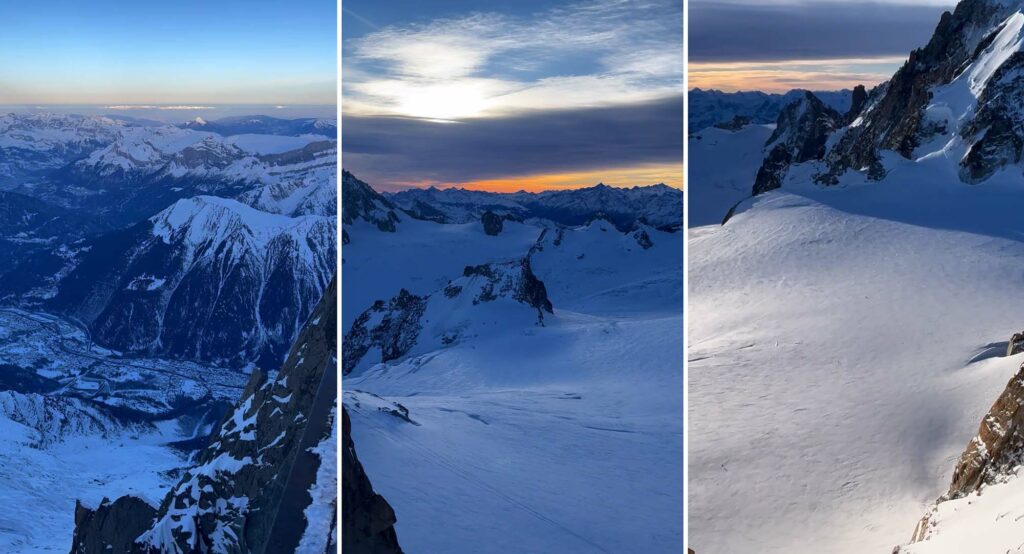
Traversing to our descent route
We strapped crampons onto our ski boots and shouldered our packs. Our guide led us to a narrow cave of ice that led out onto the ridgeline. Then we began to descend, in crampons, along a ridge of packed snow. We held onto a fixed rope railing as we slowly made our way towards less harrowing terrain. To our left was a 9000′ drop to the valley. To our right was our ski descent.
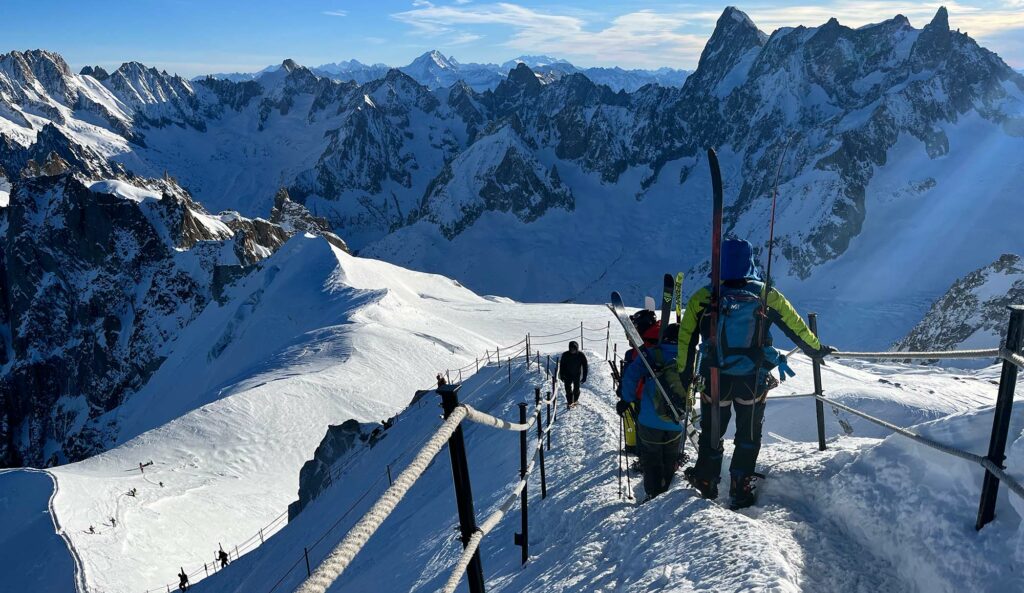
Then we pulled off the crampons and put on our skis. From here it was all downhill to the Mer de Glace, our point of exit. Numerous skiers began to descend the “standard route” down the gently sloped center of the glacier. But our guide would lead us, by request, into steeper terrain in an area known as the Grand Envers.
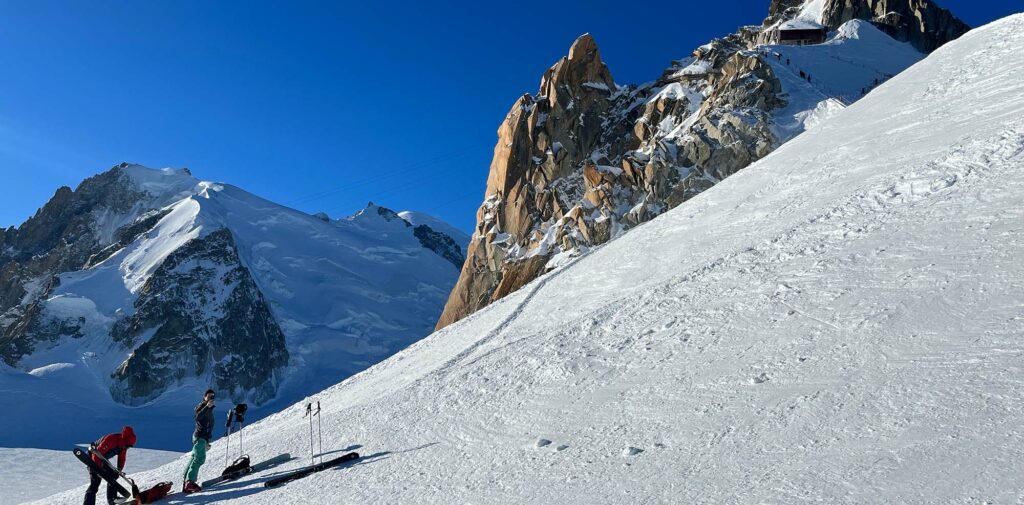
The Vallée Blanche: the world’s biggest lift-served skiing
The Vallée Blanche ski descent runs from the Aiguille du Midi down through its namesake glacier valley, to the town of Chamonix. The route runs entirely downhill from the top of the cable car to town, 9300 vertical feet (when the snow allows). This makes the descent the world’s biggest-vertical ski run serviced by a lift. Back in the US, only one location in the lower 48 comes to mind that could reliably deliver this big of a ski descent—Mount Rainier.
Unfortunately, the bottom third only allows for skiing on occasion in recent years. So we’d cut the route short about 3000 vertical feet above the town at the Mer De Glace gondola. Even still, the run would stand at over 6000 vertical feet, about 1000′ more vert than North America’s tallest resorts (Revelstoke and Whistler).

We hired a guide because the Vallée Blanche is a massive, active glacier. This means deep, dangerous crevasses that could lead to fatal falls. Plenty of folks take their chances, following “the herd” down the center of the valley. And wearing skis can mitigate a lot of risk in terms of breaking through a thin snowpack and falling to your demise. But we wanted to play it safe, and a guide would allow us to travel through much more high-consequence (and visually stunning) terrain than the standard route.
Seeking out soft snow
We came to Europe during a “dry spell” amidst a notoriously low-snow season. On the plus side, this meant our descent would involve basically no avalanche risk (and clear skies!). But on the downside, it meant firm, hard-packed snow and enhanced slide-for-life risk. That said, high winds overnight deposited soft snow on certain aspects of the terrain. As we descended, our guide sought out these slopes, through a combination of experience and just feeling out the snow.
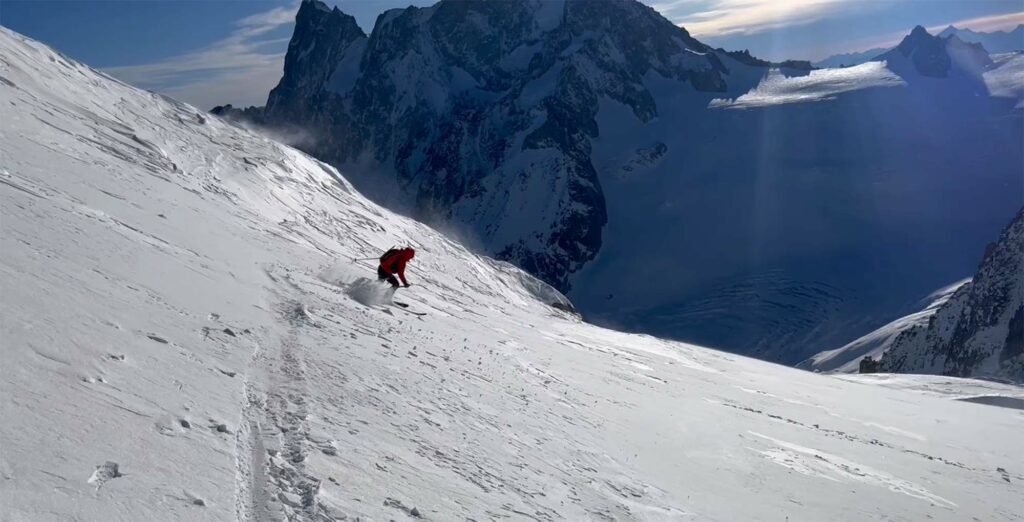
The upper third of our route featured rolling terrain … some steep-ish pitches that quickly pulled up into rolling folds in the snowpack. We skied past dramatic crevasses and massive rock faces. The scale of the scenery was simply impossible to capture by camera. It felt truly immense.
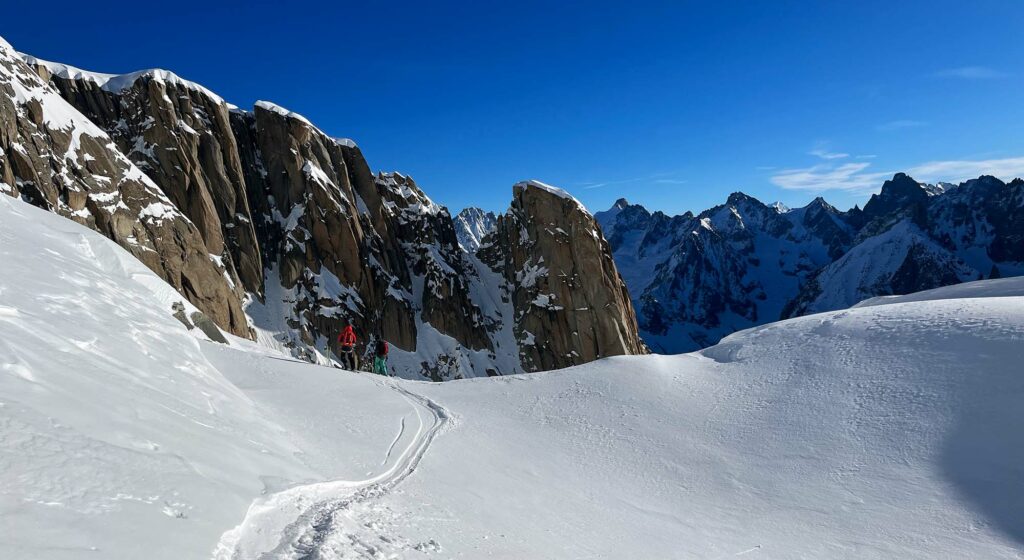
At one point during this upper third, my brother took a short fall and popped out of his bindings. Our guide grew nervous as the two of us watched him, a ways above us, search for the missing ski. If he had failed to find it, we may have had to order a helicopter rescue. Make no mistake: despite the convenience of tramways and summit restaurants, this was backcountry terrain. Ski at your own risk.
But he found his ski, and we continued down the route.
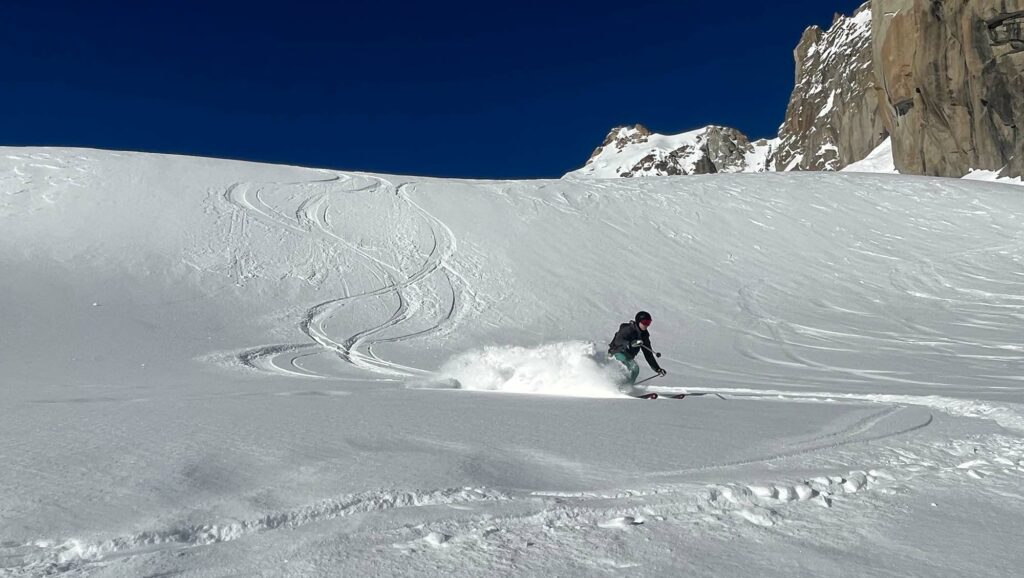
You are not allowed to fall
Then we reached what I’ll call the “middle third” of the route. I have no idea if it comprises a third of the vert or distance. But it certainly required at least a third of my mental energy. The sun fell behind rock faces and the world grew a bit darker. We had reached the steep, technical section of the descent.
Without much recent snowfall, the slopes were hard-packed and slippery. A trip-up in the wrong spot would be hard to control and recover from. And the terrain was big. Our guide put it quite simply: “you are not allowed to fall.”
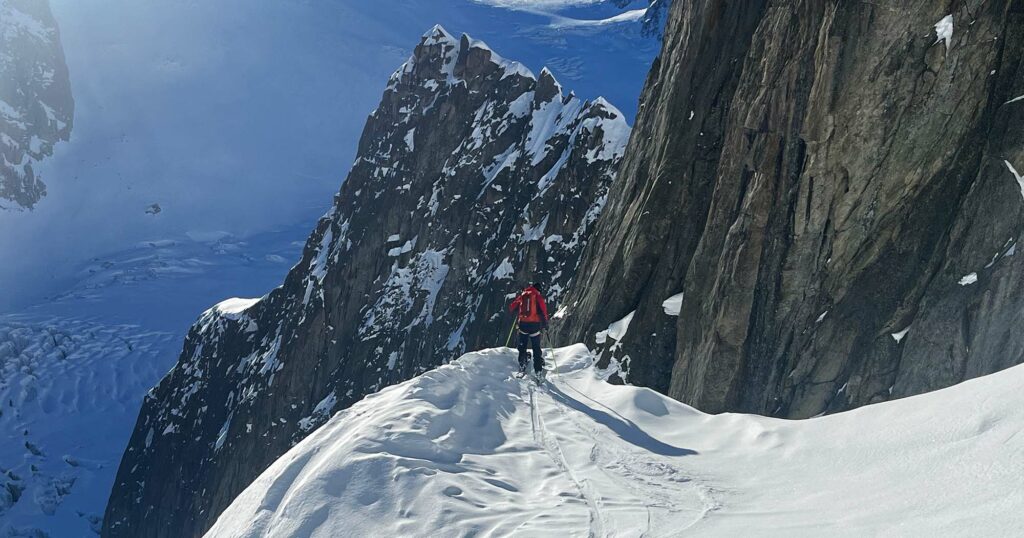
I went last here. About five years ago in Whistler, BC, I experienced an uncontrolled fall in an area of terrain known as “Spanky’s Ladder”. I slid, then “tomahawked” down about 500 vertical feet, until the terrain mellowed out a bit. There was more snow there, and the run felt steeper here. But armed with way more experience on steep Rocky Mountain terrain, I felt like the risk here was manageable.

Our guide asked if we wanted to choose a narrower and steeper direct descent or head over to something a bit wider. I suggested wider. Even so, at one point we needed to drop down a narrow rock gulley into an uncomfortably steep and narrow section. “You just need to shut your brain off” our guide instructed. Easier said than done.
Skiing Out through the Vallée Blanche
Eventually, we reached the bottom of this steep section. Our reward was a long skate across a flat glacier, back towards the standard route. Luckily this was all in the shade.
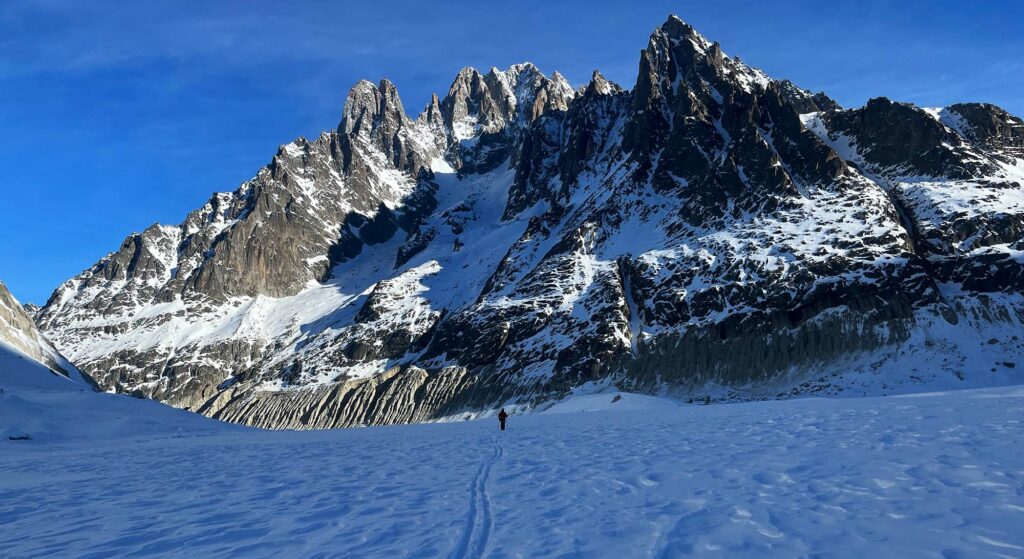
We still had about 3.5 miles of skiing left. But it was easy and fun stuff. We coasted down, back into the sunshine and packed snow. We followed a well-skied route through gentle terrain and our termination point: the Mer De Glace ice tunnels.
The Mer de Glace
This deposited us in a deep glacial valley separated from the town by a steep ridge. High above us (about 500 vertical feet) was the Montenverse train station. At one point the massive “mer de glace” glacier (Sea of Ice) filled this valley as high as the train station. But today the glacier sat far below, rapidly receding. Tons of sediment gave it the appearance of dirty sludge. It was a poignant reminder of rapid climate change.

We took a few minutes to head inside the ice tunnels, carved each year into the glacier. The tunnels burrowed deep into brilliant blue-green glacier ice. The ice represents centuries of compressed snowfall, slowly flowing downhill from Mont Blanc to town.

Then we hiked uphill to a pulse gondola that pulled us up to the train station. Just a few decades ago, the gondola reached the glacier. Today it’s a decent hike.
The three of us grabbed lunch and waited for the train ride back to town. Overall it was a beautiful and civilized approach to backcountry skiing. Very fun and very French!

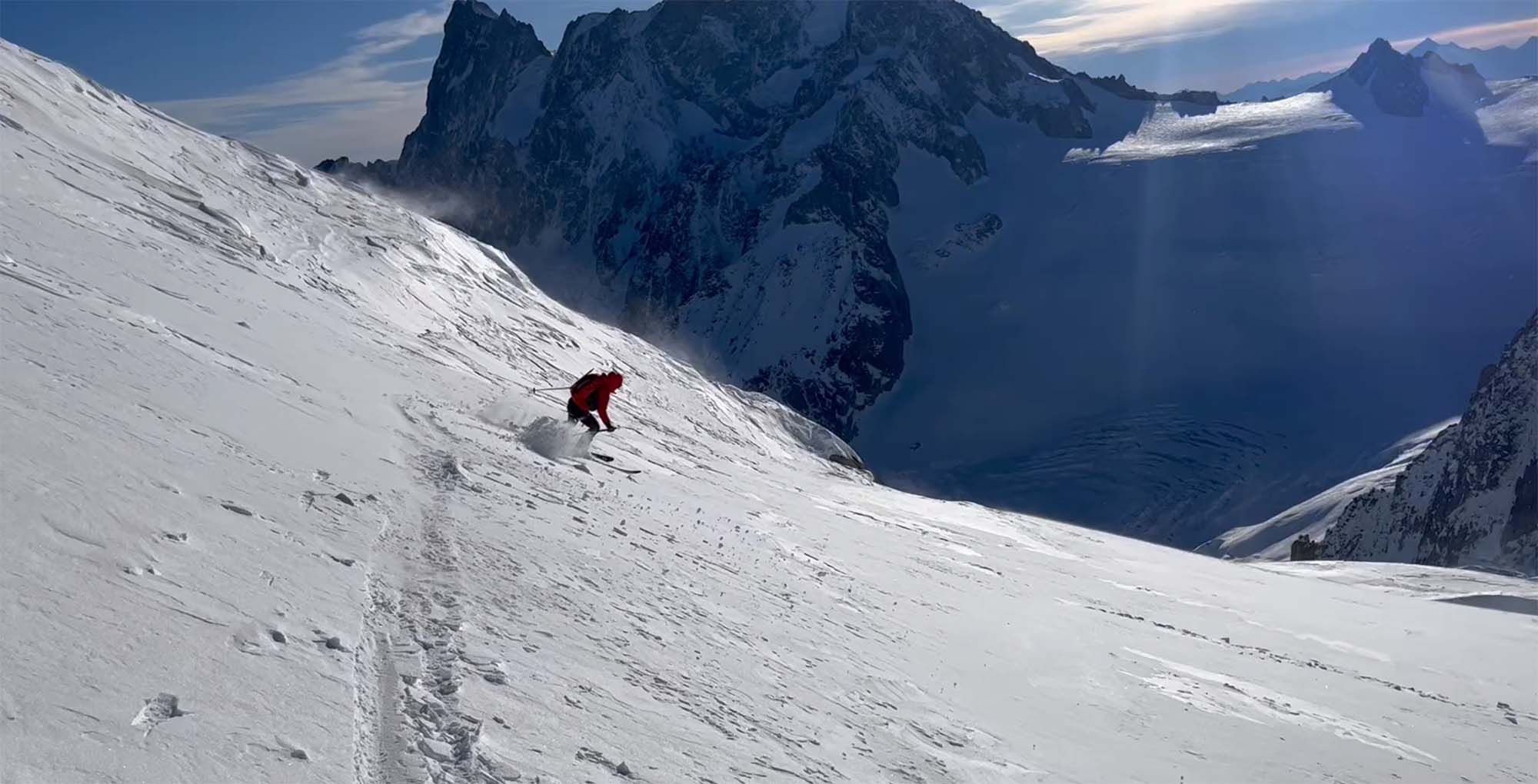
Re nearly losing a ski surely you should be using leashes when off piste?!